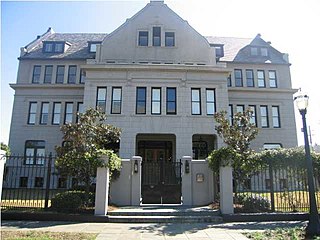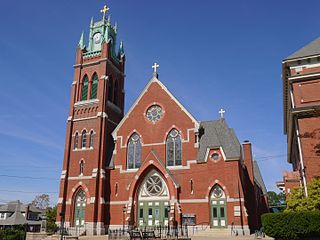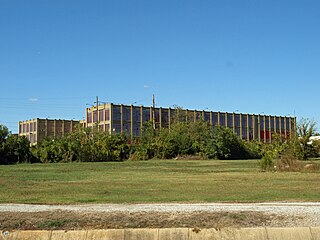
Alum Creek is a census-designated place (CDP) in Kanawha and Lincoln counties along the Coal River in the U.S. state of West Virginia. It includes the unincorporated communities of Alum Creek, Forks of Coal, and Priestley. The CDP had a population of 1,749 at the 2010 census, down from 1,839 at the 2000 census.

Woodbridge is a historic neighborhood of primarily Victorian homes located in Detroit, Michigan. The district was listed on the National Register of Historic Places in 1980, with later boundary increases in 1997 and 2008. In addition to its historic value, Woodbridge is also notable for being an intact neighborhood of turn-of-the-century homes within walking or biking distance of Detroit's Downtown, Midtown, New Center, and Corktown neighborhoods.

Abraham Lincoln Birthplace National Historical Park is a designated U.S. historic park preserving two separate farm sites in LaRue County, Kentucky, where Abraham Lincoln was born and lived early in his childhood. He was born at the Sinking Spring site south of Hodgenville and remained there until the family moved to the Knob Creek Farm northeast of Hodgenville when he was two years old, living there until he was seven years of age. The park's visitor center is located at the Sinking Spring site.

Virginia University of Lynchburg is a private historically black Christian university in Lynchburg, Virginia. The university is accredited by the Transnational Association of Christian Colleges and Schools and offers instruction and degrees, primarily in religious studies, including a Doctorate of Ministry program. The campus is a historic district listed on the National Register of Historic Places.

Claude and Starck was an architectural firm in Madison, Wisconsin, at the turn of the twentieth century. The firm was a partnership of Louis W. Claude (1868-1951) and Edward F. Starck (1868-1947). Established in 1896, the firm dissolved in 1928. The firm designed over 175 buildings in Madison.

Vawter Hall and the Old President's House are two of the oldest buildings at Virginia State University, the oldest state-supported college for blacks in the United States. Vawter Hall was built and named in 1908 in honor of the school's late rector and authority on industrial training, Charles E. Vawter. The school was originally chartered as the Virginia Normal and Collegiate Institute in 1882, created through an agreement with the Readjuster Party to found a state-supported school of higher learning for blacks.

The Club Quarters Hotel is a 16-story, 61.6 m (202 ft) Beaux-Arts high-rise at 710 Fannin Street in downtown Houston, Texas, United States. The building is listed on the National Register of Historic Places as the Texas State Hotel.

The Battle House Renaissance Mobile Hotel & Spa, is a historic hotel in Mobile, Alabama. The current structure was built in 1908 as the Battle House Hotel. It is the second hotel by that name to stand in this location, replacing an earlier Battle House built in 1852, which burned down in 1905. It is one of the earliest steel frame structures in Alabama.

The Convent of Mercy, known today as the St. Francis Place Condominiums, is a small complex of historic Roman Catholic religious buildings in Mobile, Alabama, United States. It consists of two buildings, the former convent and the former school. They were added to the National Register of Historic Places on April 24, 1992 as a part of the Historic Roman Catholic Properties in Mobile Multiple Property Submission. It, along with the Convent and Academy of the Visitation, is one of two surviving historic convent complexes in Mobile.

L'Église du Précieux Sang (also known as The Church of the Precious Blood is a historic Roman Catholic church complex at 94 Carrington Avenue and 61 Park Avenue in Woonsocket, Rhode Island, within the Diocese of Providence.
The National Register of Historic Places listings in Syracuse, New York are described below. There are 116 listed properties and districts in the city of Syracuse, including 19 business or public buildings, 13 historic districts, 6 churches, four school or university buildings, three parks, six apartment buildings, and 43 houses. Twenty-nine of the listed houses were designed by architect Ward Wellington Ward; 25 of these were listed as a group in 1996.

South Reading Academy is a historic former school building at 7 Foster Street in Wakefield, Massachusetts, US. Built in 1828–29 for the First Baptist Church, the building has served as a religious school, public high school, clubhouse, and commercial space. The building was listed on the National Register of Historic Places in 1989.

McCabe Memorial Church, also known as Iglesia Metodista Unida de la Playa de Ponce, is a historic church building in Barrio Playa in Ponce, Puerto Rico. It dates from 1908, and was designed by Antonin Nechodoma. It was listed on the U.S. National Register of Historic Places in 2008. It is one of four places such listed in Barrio Playa, the others being the U.S. Customs House, the Caja de Muertos Light, and the Cardona Island Light.

Bellevue Avenue Colored School is located in Trenton, Mercer County, New Jersey, United States. The building was built in 1883 and added to the National Register of Historic Places in 1997.

Haxby & Gillespie was an architectural firm from Fargo, North Dakota. R. J. Haxby and William D. Gillespie were the partners. The firm "produced a number of important buildings throughout North Dakota." They designed many notable public, educational, commercial, and church buildings, in North Dakota, Minnesota, and Montana.

The Lincoln Mill and Mill Village Historic District is a historic district in Huntsville, Alabama. Opened in 1900, it quickly grew to be Huntsville's largest cotton mill in the first quarter of the 20th century. After closing in 1955, the mills were converted to office space that was used by the U.S. space program. Two of the older production buildings burned in 1980, but one main building and numerous houses built for workers remain. The district was listed on the National Register of Historic Places in 2010.

The Carrington House is a bungalow located in the hamlet of Cherry Grove, New York. Built around 1912, it was one of the first buildings in Cherry Grove and constructed for Frederick Marquet. It is typical of early buildings on Fire Island. It was acquired by theater director Frank Carrington in 1927, who enlarged the house. Under his ownership, the house was a popular refuge for LGBT artists like Truman Capote; Breakfast at Tiffany's was written there.

The Congregational Church in Exeter is a parish of the United Church of Christ located on Front Street in Exeter, New Hampshire.

Woodbine Public Library, also known as Carnegie Public Library, is located in Woodbine, Iowa, United States. The library was organized in 1907, and it was initially housed in the jail section of city hall. If there was inmate in the jail the public had no access to the library. The city council appointed a board of trustees in 1908 and they applied to the Andrew Carnegie for a grant to build a library building. They received a grant on April 28, 1909, for $7,500. The Eisentraut Company, a Sioux City architectural firm designed the Prairie School building. F. X. White of Eldora, Iowa was the contractor. The building was completed in February 1909, and it was dedicated on March 9 of the same year. This was the first library built in Harrison County.

The Columbus Civic Center is a civic center, a collection of government buildings, museums, and open park space in Downtown Columbus, Ohio. The site is located along the Scioto Mile recreation area and historically was directly on the banks of the Scioto River.



















